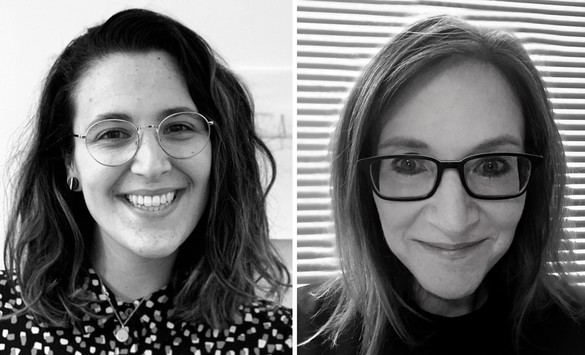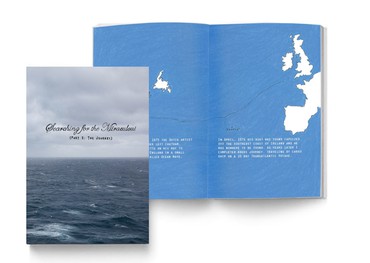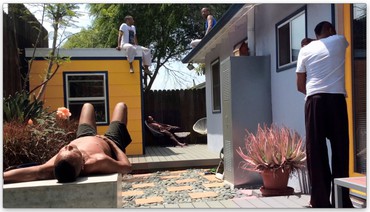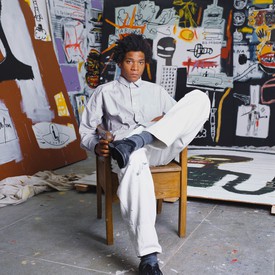
Gabriella Calandro is the director of grants and curatorial affairs at the New York Foundation for the Arts. Throughout her career she has worked across the nonprofit arts sector, holding positions in grants management, curatorial, marketing, and audience development in New York and Australia.

As the deputy director at the Foundation for Contemporary Arts, Kathleen Flynn oversees the organization’s fundraising and communication activities, and partners with the executive director on strategy and finance issues. Her previous positions include executive director at Dieu Donné and director of exhibition administration at the American Federation of Arts, among others.

Kara Vander Weg is a senior director at Gagosian, New York, where she has worked for more than fifteen years. She manages a number of the gallery’s established artists and estates, among them the Richard Avedon Foundation, Walter De Maria Collection and Archives, Michael Heizer, Neil Jenney, David Reed, Richard Serra, and Mark Tansey.
Kara Vander Weg Gabriella, could you begin by describing funding opportunities that are available for COVID-related emergency relief through the New York Foundation for the Arts (NYFA) [as of May 21, 2020]?
Gabriella Calandro Yes. In regard to what we’re currently administering for artists and the arts community, not only in New York State but across the country, we’ve had four different initiatives so far. The first was the Anonymous Was a Woman (AWAW) COVID-19 Emergency Relief Grant. AWAW approached us very early on as they saw that there were going to be many artists in need and had an allotment of money that they usually administer through their award program. We were able to get that grant up and going really quickly at the end of March. Within the first two hours we had more than eight hundred applications from artists across the country. It really underscored the overwhelming need for assistance, and we were able to establish more funds.
Now we’re administering the Tri-State Relief Fund to Support Non-Salaried Workers in the Visual Arts, which provides emergency grants for contract, freelance, or otherwise non-salaried arts workers. The Willem de Kooning Foundation, the Helen Frankenthaler Foundation, Teiger Foundation, and the Cy Twombly Foundation partnered to establish the Tri-State Relief Fund specifically for arts workers, not artists, because they recognized that there was a particular need among freelance or contract workers as they were not able to receive payment through unemployment at that time. This changed, thankfully, and some of those people can now apply for unemployment. But the foundations saw that initial need, and we worked with them to administer a program that would allow us to help that community. We’re giving out $2,000 grants to arts workers from across the Tri-State area. We closed our second cycle yesterday, and once again we saw a huge response, not only in New York State, but in New Jersey and Connecticut as well.
As we already had a very robust grants program, for us to slightly pivot our funding to address COVID-19 need at this particular time was a logical move.
Gabriella Calandro
KVW Are the grants awarded through a lottery system?
GC Yes, and with every cycle we start afresh. People who applied in the first cycle were asked to reapply in the second cycle. All applications are reviewed and then through a lottery system we administer the money. Applicants have to live in the Tri-State area to be eligible, and they have to have been working in the visual arts in some capacity and have a canceled contract or previously scheduled work that was canceled.
From our first cycle to our second cycle we learned a lot, and we’re adapting to be more accommodating and to move quickly. We’ve slightly changed the documentation that we’re asking for, because we understand that people are displaced at the moment and they might not have documents readily accessible. We want to try and make it as straightforward as possible so that everybody has an equal opportunity to receive the funding. It is still a limited pool of money and we would love to be able to help everyone. We’ve found that the lottery system helps us make it more equitable, so if you apply toward the middle or the end of the cycle, you still have the same chance as anybody else.
KVW What are the other COVID-specific funds administered by NYFA? And can you explain how NYFA works with other organizations, which I know you also did prior to the pandemic?
GC Currently we have one other fund that’s open for applicants. It’s for New York State artists living outside New York City and is a partnership with the New York State Council on the Arts (NYSCA) through their National Endowment for the Arts CARES Act funding. We already had an established history with the Council through the NYSCA/NYFA Artist Fellowship, which is in its thirty-fifth year. Since we had a limited pool of CARES funding, we thought it best to limit the opportunity to artists who were already applying as part of that preexisting partnership. This fund is now closed.
We also partnered with the Maurice Sendak Foundation for a fund that was for illustrators and writers of children’s books. That fund has now closed. We do have other funding in the works, so we recommend that people keep an eye on the NYFA website.
In terms of its history, NYFA was established in 1971 to help artists at critical stages in their careers. It does that through a learning department, fiscal sponsorship, and an awards and grants department. We have funds that are available year-round. Among these are the NYSCA/NYFA Artist Fellowship, the Canadian Women Artists’ Award, the Recharge Foundation Fellowship for New Surrealist Art, and a partnership with New York City in a grant for women in film, television, theater, and music. We have a history of supporting artists across the state of New York, and we have other programs that support artists on a national basis.
As we already had a very robust grants program, for us to slightly pivot our funding to address COVID-19 need at this particular time was a logical move. We do have our finger on the pulse of the arts community not only in the city, but across the state and nation. Many of the foundations coming to us have worked with us in the past or are looking for an organization that has an established outreach. This aligns with NYFA’s mission in supporting artists at critical stages, as this is definitely going to be a turning point for everyone.
We are grateful for all of the foundations that have reached out to us, because we feel like we’re contributing to sustaining the arts community with these opportunities and financial assistance during this difficult time.
THIS ALIGNS WITH NYFA’S MISSION IN SUPPORTING ARTISTS AT CRITICAL STAGES, AS THIS IS DEFINITELY GOING TO BE A TURNING POINT FOR EVERYONE.
Gabriella Calandro
KVW Kathleen, can you talk about the Foundation for Contemporary Arts (FCA) and how the organization was founded? You have a long history of artists supporting artists, correct?
Kathleen Flynn Yes, artists are integral to our work and our mission, and really the practice of artists supporting artists is at the heart of the organization. The Foundation for Contemporary Arts was founded in 1963 by Jasper Johns and John Cage. Some visual artists were beginning to experience a modest income from the sale of their works at that time, and they banded together to help their colleagues in the performing arts. This was done through what we believe was the first benefit exhibition: Johns, Cage, and a number of their colleagues invited artists to contribute works to that first benefit exhibition in 1963. Among the sixty-seven artists who participated are a number that we all know well: Elaine and Willem de Kooning, Roy Lichtenstein, Barnett Newman, and Andy Warhol, among others. Proceeds from those sales started our grant-making efforts.
The Foundation continues to be led by artists today. We continue to hold benefit exhibitions, and artists continue to donate works to those exhibitions. They have contributed over a thousand works to the sixteen benefit exhibitions we’ve had. Artists are the key to all of our funding efforts, as well as the ethos of the organization.
KVW You have two COVID-related initiatives that you’re now participating in: the FCA Emergency Grants COVID-19 Fund, and the Artist Relief initiative, which is funded through a consortium of organizations. Could you talk about both?
KF FCA’s emergency grants program was founded in 1993 to support artists—visual artists as well as performing artists—with urgent needs related to public presentation opportunities. In March, when we saw how the world was changing, we launched the Emergency Grants COVID-19 Fund to support artists who were experiencing a loss of income due to the postponement or cancellation of their performances or exhibitions. Those grants are $1,500 each. [On July 21, 2020, FCA announced the extension of the fund through December and increased the grant amounts to $2,000.] In terms of the application and eligibility requirements, we are funding artists who, in alignment with our mission, have experimental and contemporary practices. All applications are reviewed by our program team as well as the Emergency Grants panel, who are all practicing artists. The panel is now meeting weekly as opposed to monthly. Just for comparison, we’ve received 3,000 applications in two months, and normally we receive about 135 applications per month. So there’s a need to scale up.
The Artist Relief program is a coalition of national grant makers that came together to support artists during this time. In addition to the Foundation for Contemporary Arts, it includes the Academy of American Poets, Artcadia, Creative Capital, MAP Fund, National YoungArts Foundation, and United States Artists. We award grants of $5,000. They’re given to artists in dire financial need and in need of critical funding for housing, medical care, childcare, and other core needs.
The coalition partners have worked to ensure that the application is streamlined so that it is not a burden for artists to apply at this moment. The applications are reviewed by coalition partners and representatives from collaborating organizations that are helping us with the review process. We have five review cycles, and the third cycle opened today. We’re funding through September for this program. As of this week, the Artist Relief program will have funded 850 artists and distributed over $4 million in funding.
KVW Do you anticipate FCA participating in any other initiatives? Are there other programs under discussion? This is not a crisis that is going away in two months.
KF We’re continuing to monitor the situation. In terms of Artist Relief, the senior team is talking about how to continue to use the strength of the collective voices of this organization going forward—beyond the crisis, or beyond this initial six months that we’re funding under the current plan.
KVW Both of these are national funds. Are there particular areas that are greater in need than others across the country?
KF We’re seeing a pool that’s pretty reflective of traditional emergency grants. We see more applications in visual art categories. We’ve seen some more recent spikes in music and sound, which has a lot to do with this being the time that performances are often scheduled.
But in terms of geographic areas in need, I can’t say I’m aware of a significant difference there. I think what’s astounding is really just the need everywhere. We’ve also, through Artist Relief, been working on a survey to understand the impact of COVID-19 with artists and creative workers, and there have been sobering statistics, with sixty-three percent of artists completely unemployed, and ninety-five percent losing income as a result of this time.
KVW Gabriella, does NYFA have any statistics concerning where the need is coming from most?
GC We’ve had two national emergency grants since March, and the overwhelming need is what comes out. With the Maurice Sendak Emergency Fund, a lot of artists who applied were doing things in schools, so their income outside of illustrating or writing children’s books came with in-school appearances, and of course all of those have been canceled. The response that we had for that particular fund was overwhelming.
KVW Aside from your own organizations, where are you looking for up-to-date information on funding? Are there certain grant-giving organizations that you find to be particular helpful?
GC NYFA has a very robust emergency grants page on our website that lists a range of grants that are available nationwide, and we’re continuously updating it.
KF On the FCA website, we have links to lists of COVID-19 resources from the National Endowment for the Arts and the Department of Cultural Affairs in New York City. We have a link to resources for freelance artists from the Freelance Artist Resource Producing Collective as well.
There are links on the Artist Relief website too. Artist Relief is also doing some wellness conversations and videos to help artists holistically at the same time that we’re trying to provide funding. There’s good information on Artist Relief’s YouTube, Instagram, and website about these activities.
KVW What recommendations can you give to an artist or arts worker who is trying to make up lost income for six months?
GC It’s really important to put together evidence of scheduled events being canceled, because a lot of these funds are asking for you to show proof that something has happened. Reach out to past employers, get letters of reference, and start building a portfolio of sorts that you can refer to, because as we’ve already mentioned, this is something that will continue to go on and we hope that there will be more funds available.
KVW That’s great advice. I think many of these applications are similar, so once you go through the pain of the application one time, it makes it slightly easier the next time. It’s impressive that both of your organizations, and many grant-giving organizations in the United States, have been able to quickly come together and respond to this need. Can you talk about how that has been possible, and do you think that the grant-giving process in general will speed up because of the kind of emergency need that’s out there?
In March, when we saw how the world was changing, we launched the Emergency Grants COVID-19 Fund. . . . we’ve received 3,000 applications in two months, and normally we receive about 135 applications per month.
Kathleen Flynn
KF We did move quickly, thanks in great part to the flexibility of the organization, the board, our director, Stacy Stark, and Alexander Thompson, our program manager. We have benefited from the participation and partnership of so many artist foundations, and they acted as quickly. Without them, we wouldn’t be able to make these grants. So many of these artists were involved with the FCA very early on. Some of them are not even in the practice of making these kinds of grants, but I think recognized that artists have been hit doubly hard, between losing their creative sources of income, and in many cases also losing the other jobs that they piece together to underwrite their creative work.
The Helen Frankenthaler Foundation, Willem de Kooning Foundation, the Destina Foundation, which Dorothea Tanning started, Cy Twombly Foundation, Andy Warhol Foundation for the Visual Arts—we just couldn’t have done it without their quick support. Just yesterday, we received great news from the Barnett and Annalee Newman Foundation. To me, it is a coming together of the artistic community. Because FCA is artist-run, we felt a particularly warm and positive response from these artist foundations, as well as a number of very generous contributors, including individuals, galleries, and artists at all levels, among them former grantees who might have the ability to support us at a $10 level, which is hugely significant to us.
Artist Relief was the real call to arms, signifying that we all need to support our community and we’ll be stronger together than apart. The goal was to leverage the strengths of all seven coalition partners and to be able to work together and to quickly act in what we hope will be a significant and holistic way.
GC With NYFA, we were driven by those foundations coming to us and really wanting to do something for the community that they were seeing affected. It’s not necessarily a stretch for us, but it is slightly different in the turnover. We typically give out grants on an annual basis. We usually have a longer lead time, and there’s a lot more time to communicate and to review applications. It meant internally speeding up that process and adapting.
We’re using NYFA staff in reviewing applications, and we’re not looking at artistic merit but rather need and loss of income, which we seek through documentation. We’re very fortunate to have a very talented staff, many of whom have artistic backgrounds.
Because we are now aware that this will go on for some time, we have established a very good process that we can push forward. We want to make sure that we will have resources and opportunities available to artists in September, in October, and next year. That’s a conversation that we’re having with our potential partnering foundations, making sure that there is something still available for those artists who are too overwhelmed too apply for grants now but will be ready in a few months.
KVW You are both affiliated with some of the same organizations, including the Willem de Kooning Foundation, Cy Twombly Foundation, Robert Rauschenberg Foundation, the Roy Lichtenstein Foundation, and the Helen Frankenthaler Foundation. These were founded by important artists who came to prominence in the mid-twentieth century and left behind a financial legacy. Is that interest in funding and support something that artists today talk to you about? Are you now having artists approach you about what we can do as an arts community?
KF We see more artists volunteering to help us on the review panels, for instance. The artists on our board dedicate a substantial amount of time to the organization on an ongoing basis, and even more in a crisis situation.
I think the way that artist foundations have rallied around FCA and supported us in this effort is also mirrored with some of the current grantees doing what they can to support us. We’ve always had a benefit exhibition model that artists have supported. I do think the artist community, the galleries that support them, the arts organizations that support them, are a tightknit community that support one another. They’ve had to forever.
And in Artist Relief, my experience working with the coalition partners has been really exciting because we often do different work in the field that has some overlap, but to be able to collaborate—it’s exciting to come together as something that is greater than the sum of the parts. That’s been really enjoyable, and I hope will be a model going forward.
artists are problem solvers and lead us creatively, so I think there is a lot of hope.
Kathleen Flynn
GC It’s been inspiring to see the foundations who we all have some sort of connection to using their resources to support different types of artists or arts workers. What I am really inspired by is artists who are joining in conversations, being a sounding board for other artists—I think that as important as providing monetary funds is understanding that what you’re feeling is the same as somebody else. And unfortunately, one of the side effects of the current situation that we’re in is that we’re all separated. And artists who work in a very communal way or get inspiration from going to exhibitions and experiencing art aren’t able to do that. One of the really great things that we’re seeing throughout programs at NYFA, but also other programs that I’ve been part of, is that people are joining online, they’re asking questions, they’re connecting in a way that was unusual to us perhaps even a few weeks ago but is now becoming the norm. It’s really lovely to see people giving over a side of themselves that perhaps they wouldn’t be doing in a public realm, just so that we all know that we’re in this together. I think this will change the way that we interact in the future and the way that we work together, because we’ve all been through this common situation, and it’s not only specific to a local area like New York. This is happening on a global level. This connected state is a really good thing to come out of a very terrible situation.
KVW And maybe make us all stronger as a community. Are the grant opportunities that you’re both involved in available for artists who are in the United States under O-1 visas, or are they only for American citizens?
GC For NYFA’s emergency grants related to COVID-19, applicants just need to be able to supply a social security number or an EIN. We will not be administering 1099s on COVID-related grants.
KF Our answer would be the same. Artists with the opportunity to accept taxable income here in the United States can receive the grants without the citizenship status requirement.
KVW One last question, do you think that this will be a creative period for artists? Are you seeing evidence of this in the applications that you’re reviewing, or from conversations you’re having with artists?
KF Yes, definitely. We have a grantee, for example, who is performance-based, and he told me that he’s working on what will effectively be a performance-based installation for one visitor in his studio at this time. I know a lot of visual artists who may or may not be able to work at their usual scale or in their studio, but they are instead doing more drawing or portable work. There’s the idea of collaboration and what that means when we’re not able to be near each other. I think there are a lot of interesting discussions. And artists are problem solvers and lead us creatively, so I think there is a lot of hope.
GC Yes, I echo those sentiments. Artists are very adaptable, and they are always the face of change, and so in ten or twenty years’ time we’ll look back on this experience and see the way that it changed us.
This conversation is adapted from a webinar hosted by Gagosian on May 21, 2020. Illustrated artworks are by FCA Emergency Grants COVID-19 Fund recipients















